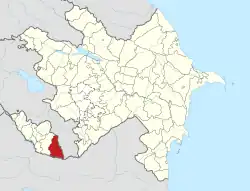Aza, Azerbaijan
Aza (until 2003,[1] Yuxarı Aza, Jukhary Aza, Yukary-Aza, and Yukhary Aza «Upper Aza») is a village and municipality in the Ordubad District of Nakhchivan, Azerbaijan. It is located in the left side of the Ordubad-Nakhchivan highway, 17 km in the south-east from the district center, on the right bank of the Gilanchay River. Its population is busy with gardening, vegetable-growing, farming, animal husbandry. There are secondary school, club and a medical center in the village. It has a population of 442.[2]
Aza | |
|---|---|
Municipality | |
 Aza | |
| Coordinates: 38°56′18″N 45°49′42″E | |
| Country | |
| Autonomous republic | Nakhchivan |
| District | Ordubad |
| Population (2005) | |
| • Total | 442 |
| Time zone | UTC+4 (AZT) |
Etymology
The former name of the village, Yuxarı (Upper) Aza means "Aza village which located in the upper side". Since 2003, the name of the village is officially registered as Aza.[1] At the various sources, this settlement is described as a small town in versions of Aza, Azar, Azat, Azad. In the location of the same city is now located, two villages of Aza and Azadkand.
Monuments
There was a ruinous Armenian church located on a hill to the west of the village.[3] The ruins of the church were completely destroyed by April 26, 2004.[3]
There was an Armenian cemetery located on the eastern edge of the village.[4] The cemetery consisted of 240–250 tombstones. The cemetery was destroyed by April 26, 2004.[4]
See also
Church of Yukhari Aza
References
- "Milli Meclis | Azerbaijan Parliament - renaming law". meclis.gov.az. Retrieved 28 February 2023.
- ANAS, Azerbaijan National Academy of Sciences (2005). Nakhchivan Encyclopedia. Vol. I. Baku: ANAS. p. 46. ISBN 5-8066-1468-9.
- Khatchadourian, Lori; Smith, Adam T.; Ghulyan, Husik; Lindsay, Ian (2022). Silent Erasure: A Satellite Investigation of the Destruction of Armenian Heritage in Nakhchivan, Azerbaijan. Cornell Institute of Archaeology and Material Studies: Ithaca, NY. pp. 188–191. Archived (PDF) from the original on 24 September 2022.
- Khatchadourian, Lori; Smith, Adam T.; Ghulyan, Husik; Lindsay, Ian (2022). Silent Erasure: A Satellite Investigation of the Destruction of Armenian Heritage in Nakhchivan, Azerbaijan. Cornell Institute of Archaeology and Material Studies: Ithaca, NY. pp. 192–195. Archived (PDF) from the original on 24 September 2022.
